|

|
Welcome to the
Mini-Mancha Information page!
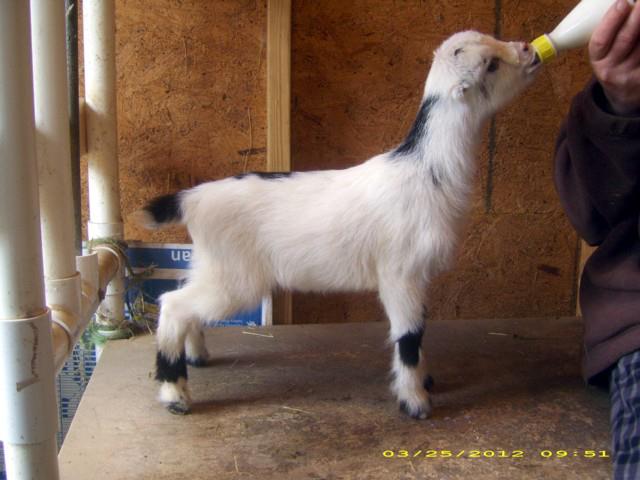
SGM Mooshine Elise - An F2 Mini-Mancha
born here on our farm in 2012.
All of the information on this page (currently)
refers to Mini-Manchas, but all of it also applies to other miniature
dairy goats (excluding Nigerian Dwarfs or Pygmies). When I say miniature
on this page I will be referring to a goat that is a decendant of a full
size dairy goat such as a LaMancha, Nubian, Alpine etc and Nigerian
Dwarf. Pygmies are not acceptable in miniature dairy goats because they
are classified as meat goats, not dairy.
Little Intro (feel free to skip to the next section if you want). :)
I use to breed Nigerian Dwarfs
on a pretty good sized scale for several years and also had Mini-Manchas
off and on over those years. The last couple years I'd been working on a
really good Mini program. My goal was to produce a smaller goat than the
full blood Lamancha, who was conformationally
correct with a well attached easy to milk udder. That doe should milk as
close to a gallon of milk daily as possible. I brought in some
excellent LaManchas and bred them with my Nigerian Dwarfs and began my
program. I had Nigerians milking a half gallon and brought in LaManchas
who milked a gallon to two gallons daily. The next year though, I decided to sell out of goats
completely. My minis went to several farms in several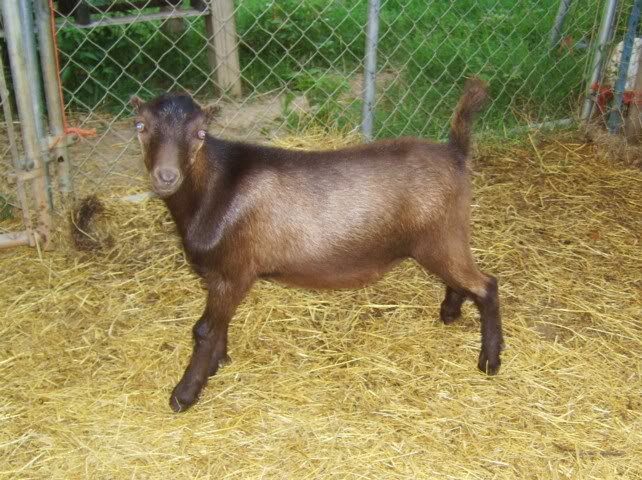 states so I'm
hoping to bring some of my own lines back in.
states so I'm
hoping to bring some of my own lines back in.
You might be wondering why I'd go through all that
trouble and then just sell out. I'll explain why... my dream from childhood up was always to
have horses. We purchased 2 more acres of land next to us and the
opportunity to FINALLY have my own horse arrived. To make it all easier,
I chose to sell the goats in order to focus fully on the horses. After a
year and a half of being goat free though, I've decided to get back into goats.
I miss them, they're quirky goofiness, the eager faces and companionship
they offer. Not to mention the gorgeous playful babies who are full of
personality and sweetness and of course the wonderful milk! So thank you
for visiting our goat page and we welcome you to take a look through our
herd and be sure to contact us with questions, comments and of course
reservations or sales. Thanks again for looking! :) ~ Ashley
Buck pictured above is 5 Cedars Suede - an F1 Mini-Mancha. |
|
Generations
If you see F1, F2, F3 etc and wonder what that means, let me
explain. The F in F1 etc means Foundation. The foundation animals in
Mini-Manchas are the purebred LaMancha and
purebred Nigerian Dwarf. Anytime you breed back to a full blood LaMancha
or Nigerian Dwarf, then you have bred back to the foundation stock. The
number behind the F tells you how many generations away from foundation
you are. Meaning how many generations you are from pure Nige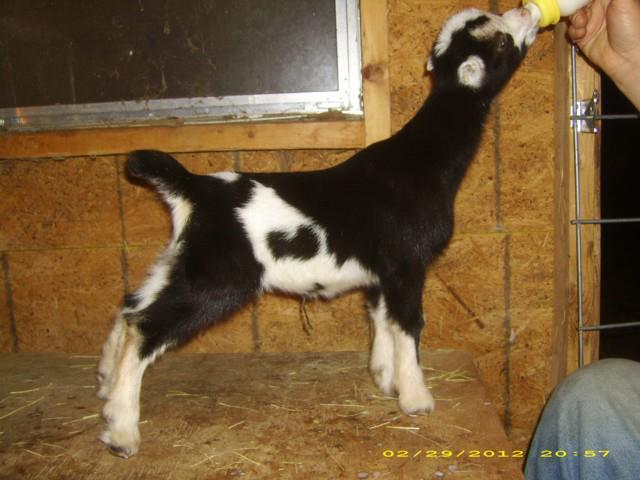 rian
or pure LaMancha animals. So for example, a
F1 goat is 1 generation from foundation animals. That F1 goat was born
from a pure Nigerian and LaMancha parents. A
F2 goat is 2 generations from foundation. It
was produced from crossing two F1 goats together. (There are exceptions
to those but we'll get to that later.)Does
that make sense? The best way I can explain how to figure out what
generation your kids will be when breeding minis is to take the lowest
generation goat of the crossing and the kid will be one generation
higher. So for example; If you breed a F1 to an F2, the kids will be one
generation higher than the lowest parent. The lowest parent is a F1, so
F2 is the kid's generation. Doesn't matter if you cross a F1 to an F6,
the kids will still be one generation higher than the lowest parent, so
the kids will still be F2s. That being said it also applies to crossing
back to foundation LaMancha
or Nigerian animals. If you cross a F2 to a LaMancha, the kids
will be still be
one generation higher than the lowest generation parent. The lowest
is foundation, so the kids will be F1s. Here's a brief chart to show
how it works too. rian
or pure LaMancha animals. So for example, a
F1 goat is 1 generation from foundation animals. That F1 goat was born
from a pure Nigerian and LaMancha parents. A
F2 goat is 2 generations from foundation. It
was produced from crossing two F1 goats together. (There are exceptions
to those but we'll get to that later.)Does
that make sense? The best way I can explain how to figure out what
generation your kids will be when breeding minis is to take the lowest
generation goat of the crossing and the kid will be one generation
higher. So for example; If you breed a F1 to an F2, the kids will be one
generation higher than the lowest parent. The lowest parent is a F1, so
F2 is the kid's generation. Doesn't matter if you cross a F1 to an F6,
the kids will still be one generation higher than the lowest parent, so
the kids will still be F2s. That being said it also applies to crossing
back to foundation LaMancha
or Nigerian animals. If you cross a F2 to a LaMancha, the kids
will be still be
one generation higher than the lowest generation parent. The lowest
is foundation, so the kids will be F1s. Here's a brief chart to show
how it works too.
LaMancha x F1 Mini = F1
F1 x F1 = F2
F2 x F2 = F3
F2 x F3 = F3
F2 x F6 = F3
F3 x F3 = F4
F4 x F5 = F5
F1 x F4 = F2
If you're still confused feel free to contact me.
Doeling pictured
above is SGM Mooshine Belle - an F3 Mini-Mancha doeling born here in
2012. |
|
Percentages
Your ultimate goal in breeding minis is to have equal amounts of LaMancha and
Nigerian Dwarf blood in the goat. The advantage to the first
few
generations of minis is to play around with different
percentages to try to get all the qualities you most want in your
mini program. For example, say you have a
really beautiful well built mini who need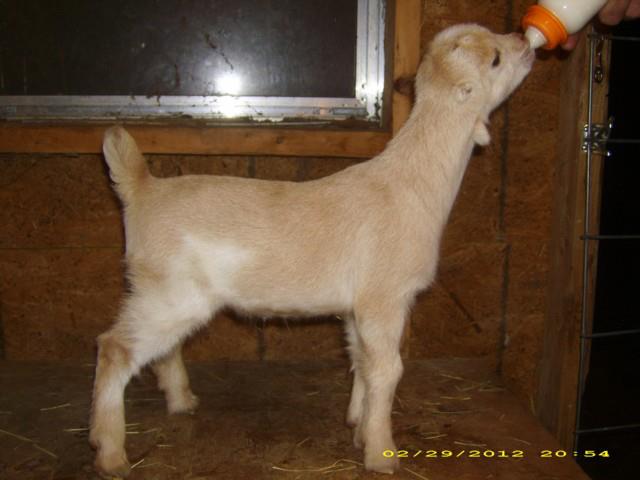 s more production. You can
always cross back to a LaMancha or high yielding Nigerian to increase
your milk production. The resulting kid will not
be 50/50 but IS still
able to be registered as an experimental. Or another example is that
you've produced a kid who has upright/erect ears. This kid IS
registerable as Experimental, however you may choose to breed back to a
full LaMancha for correct ears. s more production. You can
always cross back to a LaMancha or high yielding Nigerian to increase
your milk production. The resulting kid will not
be 50/50 but IS still
able to be registered as an experimental. Or another example is that
you've produced a kid who has upright/erect ears. This kid IS
registerable as Experimental, however you may choose to breed back to a
full LaMancha for correct ears.
When you reach your third generation with your mini program, your goal
is to be as close to 50/50 as you can be AND meeting the breed standard
(ie correct ears and height) so that you can apply for American Mini-Mancha
registration papers. The goal in breeding F3s to F5 is to show the minis
breed true. So the goal by F6s is to be meeting the standard 100%. If
the kid meets standard by F6, then you can register the kids as Purebred
Mini-Manchas.
Now all that aside, the way you figure up percentages. All you need to do is take the
Nigerian portion of the mother and add the Nigerian portion of the
father. Take that total and divide it by 2. The resulting number is
your kid's percentage of Nigerian. Do the same thing with the LaMancha
percentages of both parents and you will have your kid LaMancha percentages.
For example:
Say you have a doe who is 50% LaMancha and 50% Nigerian and a buck who
is 48.44% LaMancha and 51.56% Nigerian. You would take the percentages
for LaMancha from both parent and add them together. 50% for the doe and
the 48.44% for the buck. That gives you 98.44. Then divide that by 2.
The kids will be 49.22% LaMancha. I always calculate both the LaMancha
and Nigerian and then add them together and make sure they equal out to
100. I do this to ensure I haven't miscalculated somewhere. If you do
miscalculate just figure it up again. Its very easy to make a mistake
with calculations.
Buckling
pictured above is SGM Mooshine ... (I called him Flynn Rider) - an F3
Mini-Mancha born here in 2012. |
|
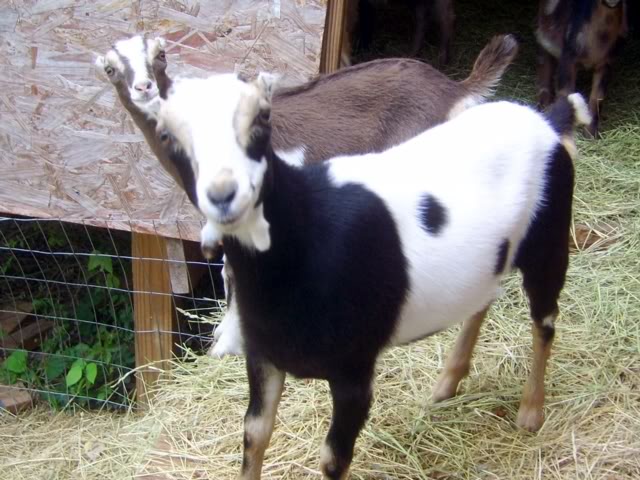 Mini
Registries Mini
Registries
To register your mini you will need the application supplied when
you buy your kid(s) from us. For either registry MDGA (Miniature Dairy
Goat Association) or TMGR (The Miniature Goat Registry) you will need to take
photos (you are welcome to use any we take of the kid while it is here).
One needs to be of the head so you can clearly see the type of ears the
kid has (straight shot or 3/4 but not a side of the head) as well as a
side body photo. It does help if you have a way to tell size of the goat
in the photo but it is not necessary. If your kid is an F3 or higher
generation, its best to wait till it is a year old before registering
because the kid who qualifies for American registration will no longer
be eligible if you register it as Experimental first. Keep that in mind
when you are registering your kids. I will post what generation and
percentage the kids from each breeding are so that should help clear up
any confusion about whether or not you should submit your kids. If you
aren't sure feel free to ask.
Does pictured above are Gotta B Kid N Z Seabreeze (foreground) and Gotta
B Kid N Katydid, both F1 Mini-Manchas that we use to own. |
|
Ears (Mini-Mancha)
Unfamiliar with ear types? There are three types of ears accepted in
the Experimental Mini-Mancha generations; upright, elf and gopher. Only
two of those three are accepted in American (elf and gopher) and for
bucks should have gopher only.
Upright Ears
Upright ears are just that, upright like Nigerian Dwarfs. In other
words, full regular ears. The kid pictured to the left below is a
Nigerian Dwarf with normal full ears. The adult doe on the right is actually a
Mini-Mancha with full ears.
 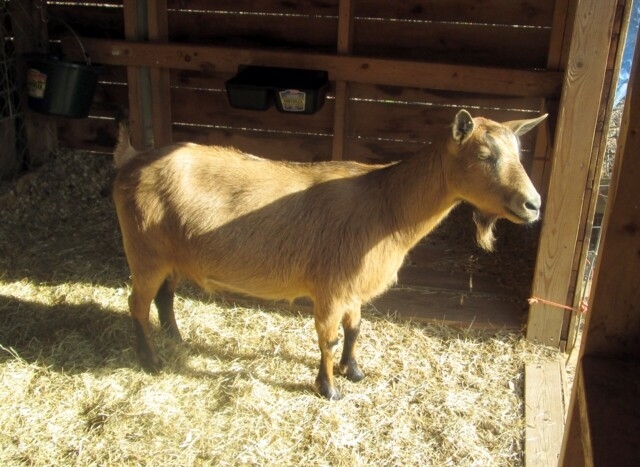
Elf Ears
Elf ears should be 2 inches or less and may have cartilage. The ear
should turn up or down as straight out is frowned upon. The doe on the
left below
has elf ears which point down. The two does in the second photo below
also have downward pointing elf ears. This straight view of their faces
does a good job of showing how much the ears project away from the head
of the goat.
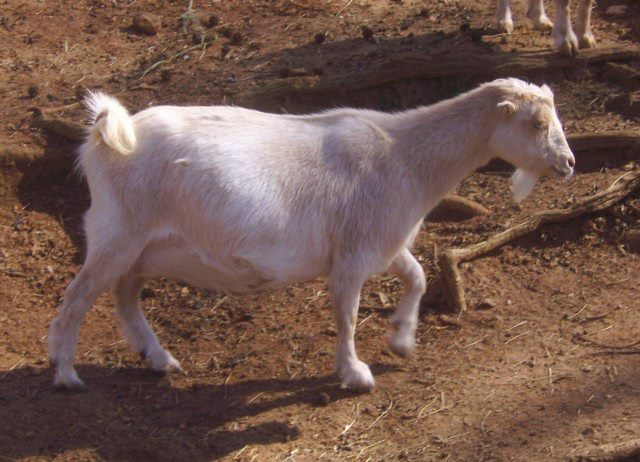 
Gopher Ears
Gopher ears should have no cartilage and can have a ring of skin
around the actual ear canal. It should look close and smooth with the
head. The kids left & middle below are minis with gopher ears.
The black kid on the right is actually a full LaMancha with gopher ears.
 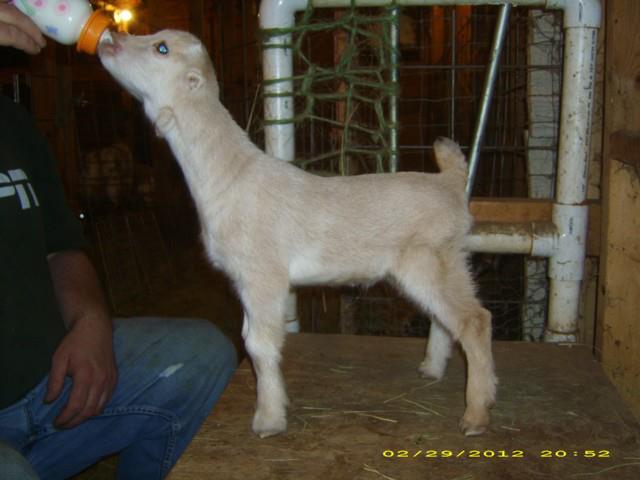  |
|
Mini-Manchas are a growing
breed. Their popularity is becoming more and more noticeable in the
Mini-Mancha market. We truly love this breed for their versatility,
hybrid vigor and incredibly cute faces. How can you not love those mini
faces? ;)
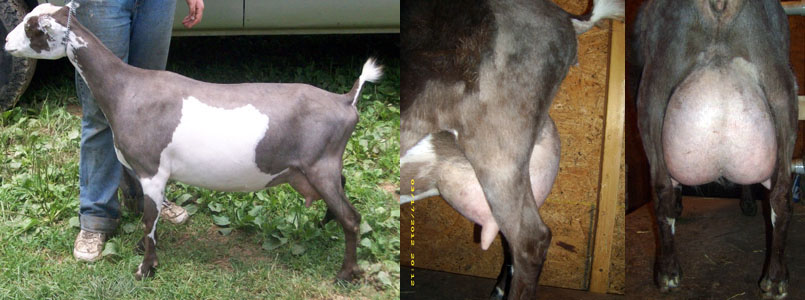
This doe is Appleberry Cove Elsie, a F1 Mini-Manchas that we use to own.
Elsie milked 3/4 of a gallon of milk. |

All pictures on this page are property of Sweet
Gum Minis.

2005-2014 Copyright Sweet Gum
Minis/Ashley Capps.
Website designed and maintained by Ashley Capps.
|
|